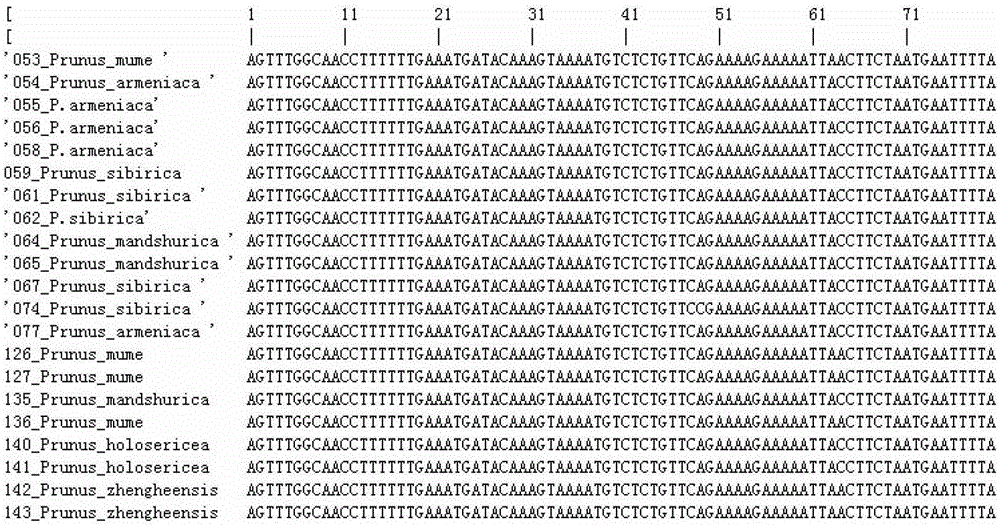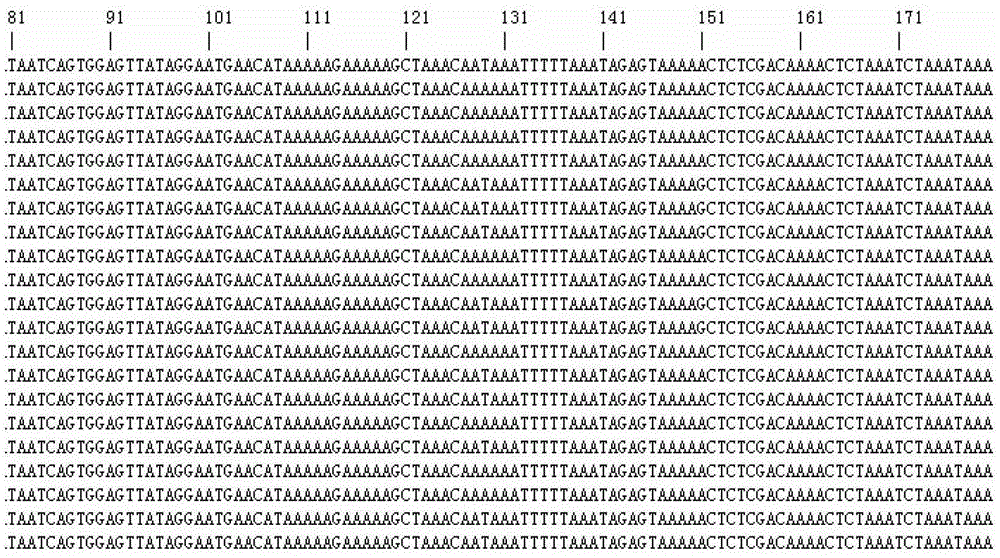Specific primer pair for identification of spermatophyte species and applications of specific primer pair
A technology for specific primer pairs and species identification, which is applied in the determination/inspection of microorganisms, biochemical equipment and methods, DNA/RNA fragments, etc., and can solve the problems of errors, unreliable identification results, and unsatisfactory primer versatility
- Summary
- Abstract
- Description
- Claims
- Application Information
AI Technical Summary
Problems solved by technology
Method used
Image
Examples
Embodiment 1
[0021] Example 1. Discovery of specific primer pairs for identifying angiosperm species
[0022] After studying the entire plant chloroplast genome, the inventor found that there are regions in the chloroplast genome that evolve faster than known marker genes, which are suitable for phylogenetic analysis and DNA barcoding. Among them, the fastest evolution is the ycf1 gene (also known as the Ycf1 gene).
[0023] The ycf1 gene is one of the few genes in the chloroplast genome with unclear functions. The ycf1 gene is located in the SSC region and the IR region, and the part located in the IR region is relatively short, generally less than 1KB, with less sequence variation. The copies located in IRb are often pseudogenized or lost in some taxa. The ycf1 gene evolves quickly, the base substitution rate is high, and the degree of variation is higher than that of the matK gene, which can be used for phylogenetic analysis. Because the ycf1 gene is longer (for example, 5706bp in the tob...
Embodiment 2
[0029] Example 2. Application of the specific primer pair designed in Example 1 to identify apricot plants
[0030] The Apricot plants used in this embodiment are as follows: Prunus armeniaca L.; Prunus holosericea (Batalin) Kostina; Prunus sibirica L.; Prunus mume Sieb.; Prunus zhengheensis J.Y. Zheng et M.N. Lu. See Table 1 for specific material information.
[0031] Table 1 Specific material information of apricot plants used in this embodiment
[0032]
[0033] 1. Take plant leaves and extract genomic DNA.
[0034] 2. Using the genomic DNA extracted in step 1 as a template, a primer pair consisting of ycf1bF and ycf1bR is used for PCR amplification to obtain PCR amplification products.
[0035] PCR reaction system (25ul): 2.5μL dNTP (2.5mmol / L), 2.5μL 10×PCR buffer (containing Mg 2+ ), the upstream primer and the downstream primer each consist of 1.25μL (5μmol / L), 0.25U polymerase, 2μL genomic DNA (20-30ng) and water.
[0036] PCR reaction program: denaturation at 94°C for 4min; den...
Embodiment 3
[0041] Example 3. Application of the specific primers designed in Example 1 to identify Chimonanthus plants
[0042] The Chimonanthus plants used in this example are as follows: Calycan thus chinensis; Calycan thusfloridus; Calycan thus occiden talis; Chimonan thus campanula tus; Chimonan thus gramma tus; Chimonan thusnitens; Chimonan thus praecox; Chimonan thus saljiangensis; Chimonan thus salicifolius; Idiospermus a traliense. See Table 2 for specific material information.
[0043] Table 2 Specific material information of the Chimonanthaceae plants used in this example
[0044]
[0045] The detection method is the same as in Example 2.
[0046] See the sequencing results Figure 11 to Figure 19 ,will Figure 11 to Figure 19 Arranged in order from left to right.
[0047] The phylogenetic tree constructed by using the primer pair composed of ycf1bF and ycf1bR to carry out PCR amplification of the specific fragments Figure 20 . The results show that the ycf1b fragment amplified from ...
PUM
 Login to View More
Login to View More Abstract
Description
Claims
Application Information
 Login to View More
Login to View More - R&D
- Intellectual Property
- Life Sciences
- Materials
- Tech Scout
- Unparalleled Data Quality
- Higher Quality Content
- 60% Fewer Hallucinations
Browse by: Latest US Patents, China's latest patents, Technical Efficacy Thesaurus, Application Domain, Technology Topic, Popular Technical Reports.
© 2025 PatSnap. All rights reserved.Legal|Privacy policy|Modern Slavery Act Transparency Statement|Sitemap|About US| Contact US: help@patsnap.com



